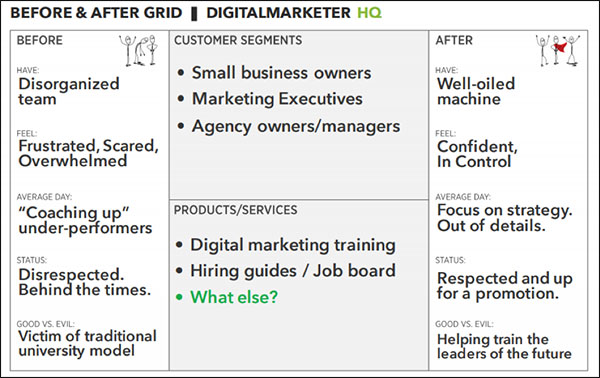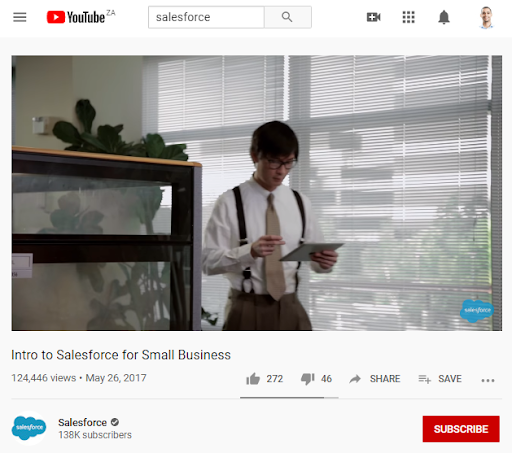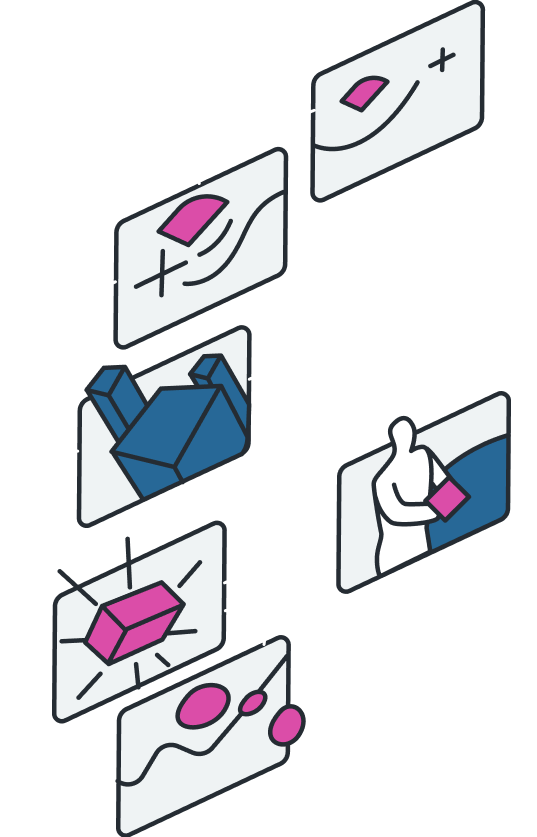Here’s the thing about B2B software marketing videos: it’s not just for brands with time on their hands. It’s a tool that every brand needs.
Why?
Because the way buyers buy has changed. According to Gartner, 27% of business buyers spend their time on online research before contacting the company they’re interested in. And research by LinkedIn shows that responsibility for influences in the B2B purchasing process is shifting. Today, 39% of executives say their responsibility has increased, a change that operations and finance professionals have also experienced.
Why does video marketing matter?
Over the years, marketers have witnessed the rise of video. Today, 95% of marketers who used video last year plan to continue doing so in 2020, and will invest more in the medium. They’ll be joined by a further 59% of marketers who hadn’t used video before.
This means that the B2B software market, like many others out there, is only going to get more competitive. Brands will ramp-up their digital footprints using video to strengthen their messaging, nurture leads, and influence buyers, and so should you.
In this blog post, I’ll share an easy-to-follow four-part framework for creating high-converting B2B software marketing videos. We’ll dig deep and explore your audience and the importance of the buyer’s journey in the context of video marketing. We’ll also look at how to ensure that your message is as powerful as possible. Lastly, I’ll show you a simple three-step process creating effective videos and offer tips to accelerate your results.
A 4-part process for producing high-converting B2B software marketing videos
Creating highly-effective marketing videos can be broken down to a repeatable process that works for anything from OTT services to powerful enterprise apps and software such as CRMs, OCR data capture, AI, machine learning, robotic process automation, and much more. It’s also much easier to understand than most think. Here’s a four-part framework for creating powerful B2B software marketing videos.
Step 1: get to know your audience and their buying behaviors
For example, SiriusDecisions uncovered that there are 6 to 10 people involved in purchases of $500,000 or more.
It’s these kinds of factors that influence the direction your marketing videos will take. Another critical factor is understanding your audience. When it comes to creating video content they will consume along the buyer’s journey, it’s important to know what their roles are, the extent of their responsibilities, and what they’re looking for in a solution like yours.
However, don’t stop there. Dig deeper and uncover the psychographics that influence their business decisions. For instance, which values do they hold near and dear to the hearts? Do they have any specific goals for their organization or department?
Also consider what challenges, pain points, and experiences do they have on the job, and what objections they might have towards your solution.
While sourcing this information may seem a little tedious, gathering it will prove fruitful. You’ll learn more about what really matters to your audience and be able to take that information and use it to produce valuable content.
Step 2: focus on how to document your B2B buyer’s journey
High-converting videos work because they’re perfectly aligned with the buyer’s journey. They are specifically designed to answer questions, address challenges, identify pain points, and educate buyers on their journey to purchasing a solution like yours.
That’s the key to creating an effective buyer’s journey. It’s all about leading your audience and making their journey as seamless as possible. As you create your buyer’s journey, build it around what your buyers experience.
Learn what questions they must answer at each phase of the buyer’s journey and incorporate notes from your persona research. Tie challenges, pain points, and aspirations to each phase, and be sure to include key educational milestones that can help accelerate buyer behavior towards the sale.
Step 3: use video to focus on “before” and “after” states to solve your buyer’s problems with your solution
Most marketers find the creative process challenging. While they have a solid grasp of who their buyers are and what they want, transforming these insights into powerful creative content seems almost impossible.
The problem?
Missing perspective. Often, personas are designed to collect qualitative insights. They are, however, not the best tool for connecting where your buyer is in their journey to where they want to be.
DigitalMarketer’s Before and After Grid is a perfect solution to this problem. Whether you’re trying to monetize live or recorded videos, using before and after states help by identifying the factors that influence buyers, leveraging them for the best possible results.
In the example below, DigitalMarketer shows what their Before and After Grid looked like for DigitalMarketer HQ, their flagship product:
Source: Digital Marketer’s Guide on Customer Value Optimization
Creating each video using before and after states helps align your message with your audience. You’ll find it easier to grab their attention and hold it with messaging that resonates.
Step 4: create captivating videos that impress and motivate buyers to take action now
With a clearer picture of who your audience is, where they are in their journey, and what they must experience, it’s time to produce your videos. You may be tempted to point a camera and hit record, but don’t. You’ll run the risk of producing videos that don’t captivate your audience.
Creating effective and enticing videos can be easily achieved if you follow a simple and repeatable, formulaic approach as we do at Explainify.
Here’s a 3-step approach you can use to create your best work.
1. Capture viewers with a powerful hook
People don’t concentrate like they used to. They are also less inclined to hang around and watch videos that don’t give them what they want immediately. To grab attention, you’ll need to deliver to hook viewers find irresistible.
Hooks are the first words of your video that viewers hear. They include a compelling reason for your viewer to stick with and continue to watch your video. To make yours effective, lead with value. You can do this in a number of ways. For example, cloud storage provider Box starts its video with a compelling idea for every professional. It’s the chance to access your files anywhere, any time and on any device.
Source: 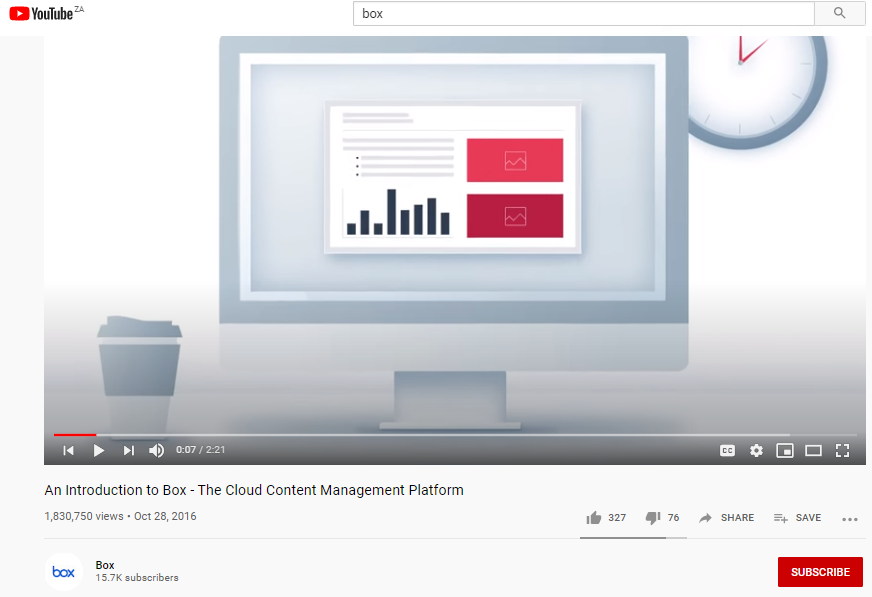 https://www.youtube.com/watch?v=3hsO11vSbx8&list=PL15C8DE981CC90E5C
https://www.youtube.com/watch?v=3hsO11vSbx8&list=PL15C8DE981CC90E5C
2. Educate and empower your B2B software buyers, don’t sell
B2B software marketing videos often includes layers upon layers of features and functions that aren’t easily explained away in one sitting. Couple with the B2B buyer’s journey, you begin to understand how your brand can’t afford to do anything but educate its audience.
The education you offer your audience is really what makes the difference. Often, brands don’t take time to close the knowledge gaps for buyers, resulting in less-than-prepared leads.
As you consider the educational element for your videos, think about it in the context of your buyer’s journey and what they need to know at each stage. As buyers build on their knowledge, they begin to feel a sense of confidence about their ability to better define problems they have, how to solve them, and how your product fits the bill.
Salesforce offers a collection of demos on its YouTube channel. They are often short, relatable, and peel back the veil of the software, making it easier to learn about before committing. In this video, small businesses learn how to use Salesforce by following Carl as he runs and grows his business.
Source: https://www.youtube.com/watch?v=zDBSLcGp-80
3. Use a strong, personalized CTAs throughout your videos
Calls to action are musts. They help connect the dots between your videos, gently guiding buyers from one video to the next. But for your call to action to be strong, it’s got to be personalized. Today, you may be finding that more and more of your buyers are millennials, people with strong views on personalization.
Salesforce found that half of the millennials and Gen Z’ers generally ignore communications from companies that don’t personalize their content.
The solution?
As you create your videos, be sure to take the next step in the buyer’s journey clear with a personalized call to action.
“Download” or “learn more”, aren’t enough.
“Agile project manager? Learn how our project management software is built for you” is perfect.
Tips on how to create amazing B2B software marketing videos that convert leads into buyers
While you have everything you need to create powerful B2B software marketing videos, there are ways to accelerate your learning curve. Below is a collection of three tips for elevating your videos.
Create engaging thumbnails
Thumbnails the first to elements viewers see when looking at a video, especially if you’re using social media or YouTube to promote your content. The challenge most marketers experience on these platforms is getting users to stop and click in the videos. The only way to grab attention is by creating engaging thumbnails.
Use colors that stand out on the platform you’re sharing your video on. For example, YouTube uses grey and white as primary colors. Quickbooks uses a gradient color strip with green and blue, something that breaks the platform’s color scheme and quickly pulls the viewer’s eye in.
Maintain attention with pattern interrupts
Video watch time is one of the biggest challenges and most important metrics for videos online. On YouTube, whether your video is about live streaming tech or site software, or fulfillment software, watch time influences how well your video rank and result. If you find that your videos get clicks but viewers seldom watch 50% or more of your content, pattern interrupts may be the key.
Pattern interrupts have their foundation in the study of neuro linguistic programming. A pattern interrupts is the introduction of a brand-new idea, one that catches your viewers off guard. As the idea introduced, viewers can’t help but latch on to better understand it. Buffer used pattern interrupts on their YouTube channel and grew it by 61% in 30 days, proof that they work.
They are also easy to implement in your videos. For example, you could interrupt a viewer’s thought pattern by introducing a new sound, image, or frame to your video to better explain a concept.
Monday.com uses humor. In their video titled “Manage Every Part of Your Business”, you’re constantly challenged by funny workspace experiences. Some are relatable, while others are just crazy, communicating how versatile their software is.
Source: 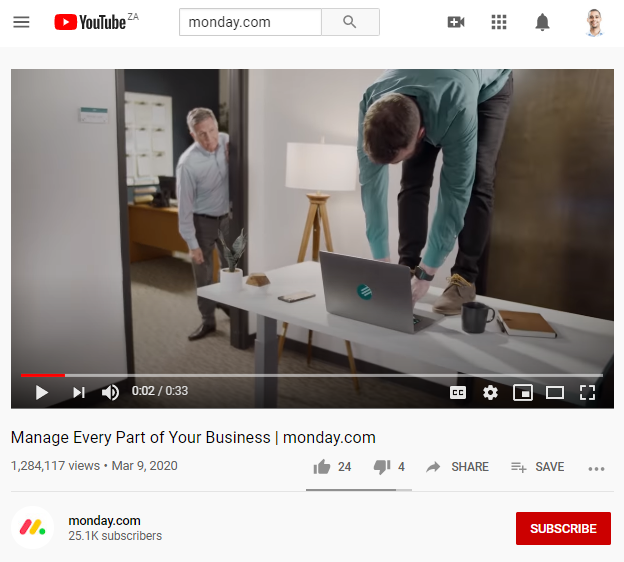 Manage Every Part of Your Business – monday.com
Manage Every Part of Your Business – monday.com
Cultivate trust
Trust accelerates the sales cycle, but it’s tough to build online. Marketers also tend to spend more time driving sales messages, making it harder to show buyers that they can be trusted.
As you create your videos, apply the ‘Know, Like, and Trust’ concept. It’s all about helping buyers see your brand as a real and valuable solutions provider, one they can trust.
How do you apply ‘Know, Like, and Trust’ in your videos?
Create content that isn’t sales-focused. Produce top-of-funnel and middle-of-funnel content that educates before driving strong sales messaging. This way, buyers will be exposed to branded educational content and become familiar with what your brand’s all about. As they learn more, they’ll trust more and become open to committing.
HubSpot goes a great job of growing its audience with amazing content from HubSpot Academy on YouTube. Buyers interested in inbound marketing get to learn the ins and outs of the discipline from the brand that coined the concept. What could be more compelling than that?
Source:  HubSpot Academy YouTube Video Playlist
HubSpot Academy YouTube Video Playlist
Conclusion
Video is a powerful tool for converting leads into buyers for B2B software brands that need to provide on-demand self-educating and self-servicing content for their potential clients. To make it work for yours, take the time to learn about your audience and what matters to each influencer in the buying process. After all, sales and selling is all about connecting the dots between a problem and your solution. The more videos you create that guide and educate buyers with valuable content, the more trust and positive results you’ll see.


